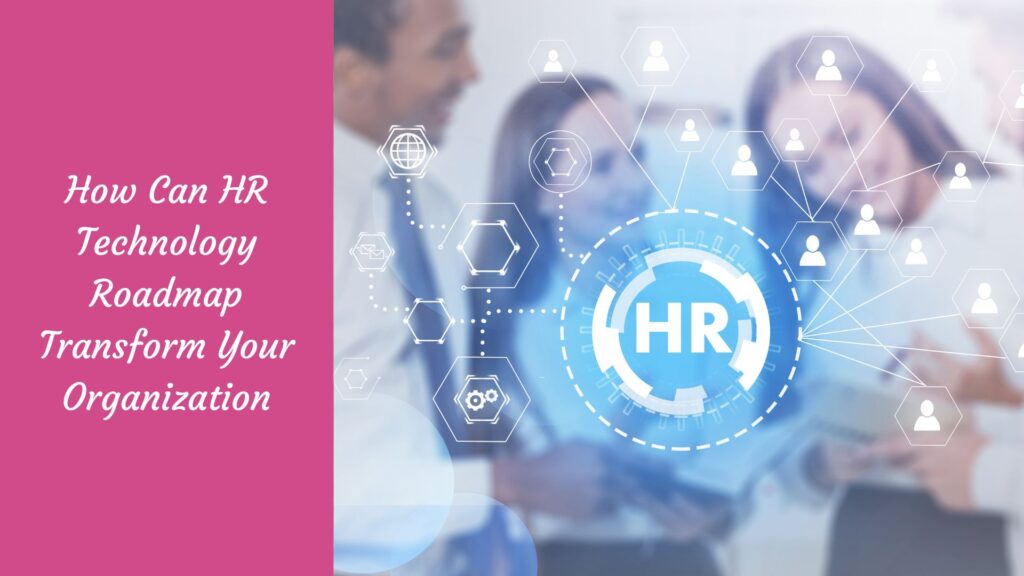In the realm of Human Resources (HR), technology has emerged as a powerful game-changer, revolutionizing traditional practices and reshaping the employee experience. But here’s the thing: a well-structured HR technology roadmap is no longer just a choice; it’s an absolute necessity for organizations aiming to thrive with utmost efficiency and unparalleled success. 🚀💼
Picture this: an HR roadmap that seamlessly transforms your operations, making them streamlined, data-driven, and future-focused. ✨📈
Intrigued? 😃
In this post, we’ll dive deeper into how an HR technology roadmap can unleash unprecedented growth and success for your organization. Get ready to be inspired! 💪🌟
What is HR technology roadmap?
An HR technology roadmap is a strategic blueprint that outlines the suite of technological tools, solutions, and systems an organization plans to implement in its HR department over a defined timeline. 📅
This roadmap serves as a comprehensive guide, helping organizations align their HR technology investments with their overarching business goals, and ensuring seamless integration of these tools into the existing infrastructure. 💼✨

- Planning Tools: These are used to create, manage, and track HR-related schedules and tasks. These tools can encompass everything from leave management systems to workforce planning applications.
- Recruitment Software: This includes platforms designed to streamline the entire hiring process, from posting job listings and screening applicants to scheduling interviews and onboarding new hires.
- Performance Management Systems: These tools provide a platform for conducting regular performance reviews, setting and tracking goals, and providing feedback.
- Employee Engagement Platforms: These tools are designed to enhance employee engagement and morale, often including features for peer recognition, rewards, surveys, and communication tools.
- Learning and Development (L&D) Tools: L&D tools help organizations deliver, track, and manage training and development programs for their employees.
The timeline of a typical HR technology roadmap might look something like this:
- Short term (0-6 months): Implement planning tools and recruitment software.
- Medium term (6-12 months): Introduce performance management systems and employee engagement platforms.
- Long term (1-2 years): Invest in and implement advanced L&D tools.
Hence, an HR technology roadmap is instrumental in guiding an organization’s HR technology journey, ensuring sound investment decisions, seamless implementation, and maximized returns. 🗺️✨💼
Importance of HR technology roadmap

Here are several key reasons why an HR technology roadmap is of significant importance:
- Alignment With Business Goals: A roadmap ensures that HR technology investments align with the overall business goals. For instance, if a company’s primary objective is to accelerate growth, the roadmap might prioritize recruiting software to attract and hire the best talent.
- Optimization of Resources: By outlining the HR technology journey, organizations can better plan and allocate resources, reducing wasteful spending and ensuring maximum ROI. For example, an organization might decide to invest first in performance management systems before implementing costly L&D tools.
- Improved Decision Making: The roadmap can guide decisions about when and how to implement various HR technologies, reducing risks and enhancing outcomes. For example, a company might decide to roll out an employee engagement platform before a major organizational change to ensure strong internal communication and support.
- Increased Employee Satisfaction: HR technologies can significantly improve the employee experience, from streamlined recruitment processes to personalized L&D programs. This can result in higher employee satisfaction and retention rates.
- Future-Proofing the Organization: An HR technology roadmap helps organizations stay ahead of the curve by incorporating future trends and innovations into their HR practices, ensuring they remain competitive in the evolving business landscape.
How to implement HR technology roadmap
Implementing an HR technology roadmap requires methodical planning, strategic execution, and continuous monitoring. Here’s how to navigate the process: 🗺️✨

1. Identify Business Goals: The first step is to identify your organization’s overarching business goals. What targets do you hope to achieve through the implementation of HR technology? Perhaps it’s improved recruitment, better employee engagement, or more efficient performance management. By establishing these goals upfront, you can ensure that your HR technology roadmap is aligned with them from the outset.
2. Conduct a Technology Audit: It’s crucial to assess your existing HR technology landscape. Identify which tools are currently in use, their effectiveness, and any gaps in your tech stack. This step helps to avoid duplication and ensures that any new technologies you introduce will complement and enhance your existing tools.
3. Prioritize HR Technologies: Once you’ve identified your goals and assessed your current landscape, it’s time to prioritize the HR technologies you need. This prioritization will depend on your specific goals. For instance, if your primary objective is to improve the recruitment process, sophisticated recruitment software should be high on your list.
4. Develop a Timeline: Create a realistic and strategic timeline for the implementation of these technologies. Start with the most pressing needs and move towards long-term technology investments. A phased approach, like the one outlined in the example HR technology roadmap, is a good strategy to follow.
5. Assemble the Right Team: It’s essential to put together a cross-functional team responsible for the successful execution of the roadmap. This team should include HR professionals, IT experts, and representatives from other relevant departments.
6. Manage Change Effectively: The implementation of new technology often involves significant change. Effective change management strategies, including clear communication, staff training, and ongoing support, are crucial for successful implementation.
7. Monitor and Adjust: Once the HR technologies are rolled out, it’s important to continuously monitor their performance and impact. Are they meeting your original objectives? Is there room for improvement? Regular reviews and adjustments can keep your HR technology roadmap on track and help your organization maximize the benefits of HR technology.
By following these steps, you can strategically implement your HR technology roadmap, ensuring a seamless integration of tech tools that drive efficiency and success for your organization. 🚀💻🔧
7 Examples of Digital Transformation in HR technology roadmap
Here are seven examples of digital transformation in an HR technology roadmap:

- Artificial Intelligence in Recruitment: Many organizations are implementing AI-powered recruitment software. These tools streamline the hiring process by automating tasks like CV screening and interview scheduling, allowing HR teams to focus more on candidate interaction and decision-making.
- Learning Management Systems (LMS): An LMS is a digital platform that delivers, tracks, and manages training. Many companies are incorporating LMS in their HR technology roadmap to personalize learning, driving employee engagement and development.
- Cloud-Based HRMS: A cloud-based Human Resource Management System (HRMS) is another example of digital transformation. HRMS unifies many HR functions, such as payroll, benefits administration, and performance analysis, providing a centralized platform for HR data.
- Employee Self-Service Portals: These portals have been a game-changer in HR technology, empowering employees to manage their personal data, benefits, and training. It not only boosts employee satisfaction but also reduces the administrative burden on HR.
- People Analytics Tools: People analytics tools gather, analyze, and use HR data to drive decision-making. These tools provide insights about employee performance, engagement, and retention, supporting strategic HR and business decisions.
- Virtual Reality (VR) in Training: Some forward-looking organizations are introducing VR to deliver immersive training experiences. VR can simulate real-world scenarios for training purposes, enhancing learning outcomes and employee readiness.
- Chatbots for HR Support: Chatbots are being used for HR support, providing instant responses to common employee queries. This technology improves efficiency, freeing up HR professionals to focus on more complex tasks.
Each of these examples reflects a strategic integration of technology into HR practices, transforming traditional ways of working and driving efficiency, effectiveness, and employee satisfaction. 🚀💡🌟
The Stages of HR technology roadmap Digital Transformation
The stages of HR technology roadmap digital transformation can be broadly classified into the following categories: 🚀✨🔧

1. Awareness: The initial stage of digital transformation involves recognizing the potential benefits of integrating technology into HR practices. It entails an understanding of the changing digital landscape and its impact on HR functions. The organization identifies the need to leverage technology to streamline HR processes and enhance efficiency.
2. Strategy Development: In this stage, the organization formulates a clear strategy for the digital transformation of its HR functions. This strategy typically includes defining objectives, prioritizing HR technologies, conducting a technology audit, and developing a timeline for implementation.
3. Implementation: At this stage, the organization begins to put its digital transformation strategy into action. It involves rolling out prioritized technologies, training employees for the transition, and managing the change effectively.
4. Adoption: After the technologies have been implemented, the focus shifts to ensuring that all employees are comfortable using them. This stage involves providing ongoing support and additional training if necessary.
5. Evaluation: The final stage of the digital transformation process involves analyzing the effectiveness of the new technologies. HR teams monitor key performance indicators (KPIs) to assess whether the digital transformation is meeting its objectives. If there are areas for improvement, adjustments are made accordingly.
HR technology roadmap to HR Digital Transformation

The HR technology roadmap to digital transformation is a strategic plan that guides the shift from traditional HR practices to technologically-enabled processes. 🗺️ The transition is generally phased to ensure smooth integration and minimal disruption to existing operations. Here is a step-by-step guide on how to create an HR technology roadmap: 📝
1. Objectives Definition: Begin by defining the objectives of your HR digital transformation. What do you hope to achieve? This could be anything from streamlining HR processes to enhancing employee engagement or leveraging data for strategic decision-making.
2. Technology Audit: Conduct a thorough technology audit to understand your current HR technology landscape. Identify the tools and systems currently in use and assess their effectiveness. It will help you identify gaps, redundancies, and areas for improvement.
3. Prioritization of Technologies: Based on the audit results, prioritize the technologies you need to implement. The most pressing needs typically include a Human Resource Management System (HRMS), Learning Management System (LMS), and people analytics tool.
4. Strategy Formulation: Outline a clear strategy for the implementation of your prioritized technologies. It should include a timeline, a resourcing plan, and a change management strategy.
5. Team Assembly: Assemble a cross-functional team to oversee the transformation process. This team should include HR professionals, IT experts, and representatives from other relevant departments.
6. Implementation and Training: Implement your prioritized technologies in a phased manner. Provide necessary training to employees to ensure they can effectively use the new technologies.
7. Evaluation and Adjustment: Regularly evaluate the effectiveness of the implemented technologies. Use key performance indicators (KPIs) to measure success. Make adjustments as necessary based on these evaluations.
13 Myths About HR Digital Transformation
There are many misconceptions surrounding the digital transformation in Human Resources. 🤔 These myths can hinder progress and create unnecessary fears among businesses. Let’s debunk the 13 most common myths about HR digital transformation! 💪🚀😃

1. It’s all about technology: While technology is an integral part of digital transformation, it’s not the only aspect. Digital transformation also involves a change in culture, processes, and workforce capabilities.
2. Digital transformation is an IT project: Many believe the IT department solely conducts digital transformation. However, successful digital transformation requires collaboration across all departments, led by HR.
3. It’s too expensive: Digital transformation does require investment, but it’s not just for large companies with big budgets. With scalable solutions, even small companies can embark on digital transformation.
4. It’s a one-time event: Digital transformation is a continuous process, not an event. It involves consistent updates, monitoring, and improvements.
5. It’s too complex and risky: Yes, digital transformation can be complex, but with a well-planned and phased approach, the associated risks can be minimized.
6. Only young employees can adapt: This is a misconception as digital transformation is about mindset, not age. With the right training and support, employees of all ages can adapt.
7. It will lead to job losses: While some roles may become obsolete, digital transformation can also create new roles and opportunities for growth.
8. It’s just a trend: Digital transformation is not a passing trend. It’s an organizational necessity in today’s digital age.
9. It’s all about efficiency: While efficiency is a big part of it, digital transformation also aims to improve employee experience, drive innovation, and enable better decision-making.
10. It eliminates the human touch: While automation can replace certain tasks, it cannot replace the need for human interaction. HR digital transformation aims to free up time for HR professionals to focus on strategic and interpersonal aspects.
11. It’s not for every industry: Every industry can benefit from digital transformation, from healthcare to education to manufacturing.
12. Implementation equals success: Simply implementing new technologies does not guarantee success. Success depends on how effectively the technology is used and integrated into daily operations.
13. Digital transformation happens overnight: Digital transformation is a journey. It requires patience, persistence, and a willingness to adapt to change.
Conclusion
HR digital transformation is a thrilling journey unique to each organization. 🚀 It’s not a one-size-fits-all process but rather a path paved with challenges and opportunities. 💪
By setting clear objectives, prioritizing technologies, fostering collaboration, and continuously evaluating progress, HR teams can navigate the ever-changing digital landscape and drive meaningful transformation. 🌟
So, let’s embrace the change and embark on your HR technology roadmap today! Remember, digital transformation is an ongoing adventure, not a final destination. Keep evolving and adapting to stay ahead of the curve in this dynamic digital age. Let’s make HR history together! 🙌

10+ years experience in Marketing and Operations
